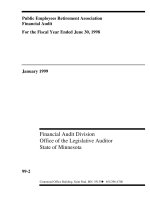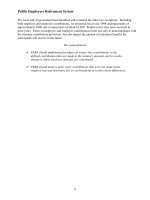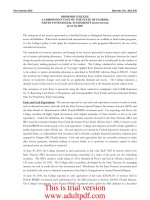Department of Children, Families & Learning Statewide Audit – Selected Programs Fiscal Year Ended June 30, 1998 March 1999 _part1 pdf
Bạn đang xem bản rút gọn của tài liệu. Xem và tải ngay bản đầy đủ của tài liệu tại đây (215.58 KB, 10 trang )
Department of Children, Families & Learning
Statewide Audit – Selected Programs
Fiscal Year Ended June 30, 1998
March 1999
Financial Audit Division
Office of the Legislative Auditor
State of Minnesota
99-13
Centennial Office Building, Saint Paul, MN 55155 651/296-4708
SUMMARY
State of Minnesota
Office of the Legislative Auditor
1st Floor Centennial Building
658 Cedar Street • St. Paul, MN 55155
(651)296-1727 • FAX (651)296-4712
TDD Relay: 1-800-627-3529
email:
URL:
Department of Children, Families & Learning
Selected Programs
Statewide Audit Fiscal Year 1998
Public Release Date: March 5, 1999 No. 99-13
Agency Background
The Department of Children, Families & Learning is responsible for providing educational assistance to school districts
and local educational agencies. In addition, the department provides programs that address social and economic concerns,
such as the Head Start Program and energy, health, and nutrition programs. The department is funded primarily from
General Fund appropriations and federal grants. Department expenditures for fiscal year 1998 totaled approximately
$4 billion. Mr. Robert Wedl was the commissioner of the department during our audit scope. In January 1999, the
Governor appointed Ms. Christine Jax as the new commissioner.
Selected Audit Areas and Conclusions
Our audit scope was limited to those activities material to the State of Minnesota’s general purpose financial statements
for the year ended June 30, 1998, and to the federal Single Audit objectives. Our primary audit objective was to render an
opinion on the State of Minnesota’s financial statements. Our scope within the Department of Children, Families &
Learning included General Fund School Aids, Maximum Effort School Loans, and Endowment School Apportionment
Aids. Federal programs included Title I Grants to Local Educational Agencies, Special Education State Grants, Child and
Adult Care Food, Low Income Home Energy Assistance, Child Care and Development, and Adult Education State Grants.
We qualified our report, dated December 1, 1998, on the State of Minnesota’s financial statements because insufficient
audit evidence exists to support the State of Minnesota’s disclosures with respect to the year 2000. Auditing the state’s
year 2000 compliance efforts was not an objective of this audit. As a result, we do not provide assurance that the
Department of Children, Families & Learning is or will be year 2000 ready, that its year 2000 remediation efforts will be
successful in whole or in part, or that parties with which the Department of Children, Families & Learning does business
will be year 2000 ready.
For the areas audited, the Department of Children, Families & Learning’s financial activities were fairly presented in the
general purpose financial statements of the State of Minnesota for the year ended June 30, 1998. However, we did
identify two concerns relating to financial reporting. The department did not certify some liabilities to the Department of
Finance. In addition, the department did not prepare supplemental federal expenditure schedules accurately and timely.
For the federal programs tested, the department complied, in all material respects, with the types of compliance
requirements described in the U.S. Office of Management and Budget (OMB) Circular A-133 Compliance Supplement
that are applicable to each of its major federal programs for the year ended June 30, 1998. However, we identified certain
weaknesses in internal control and noncompliance with program requirements. For the Low Income Home Energy
Assistance Program, we identified concerns relating to the refund process, the Cash Management Improvement Act,
recording of grant amounts, and monitoring of subrecipients. We also found that the department did not accurately
prepare a quarterly report for the Child Care and Development Program and did not review the manual entries of county
expenditures for the program. Finally, the department did not monitor Adult Education subgrantee administrative
expenditures.
The Department of Children, Families & Learning agreed with the report conclusions. The department has started
corrective action to resolve several of the audit issues.
Department of Children, Families & Learning
Table of Contents
Page
Management Letter 1
Status of Prior Audit Issues 8
Department of Children, Families & Learning Response 9
Audit Participation
The following members of the Office of the Legislative Auditor prepared this report:
Claudia Gudvangen, CPA Deputy Legislative Auditor
Renee Redmer, LPA Audit Manager
Joan Haskin, CPA, CISA Auditor-in-Charge
Brad Falteysek Auditor
Anna Lamin Auditor
Charlie Klein Auditor
Kristine Helstrom Intern
Exit Conference
The findings and recommendations in this report were discussed with the following staff of the
Department of Children, Families & Learning on February 17, 1999:
Christine Jax Commissioner
Barbara Yates Deputy Commissioner
Cindy Lavorato Assistant Commissioner
John Bulger Agency Finance Manager
Mark Kaszynski Office of Energy
Cherie Kotilinek Child Care Assistance
Barry Shaffer Adult Basic Education
Troy Vick Child Care Assistance
Don Johnson Fiscal Services
Bill Anderson Fiscal Services
STATE OF MINNESOTA
OFFICE OF THE LEGISLATIVE AUDITOR
JAMES R. NOBLES, LEGISLATIVE AUDITOR
Representative Dan McElroy, Chair
Legislative Audit Commission
Members of the Legislative Audit Commission
Ms. Christine Jax, Commissioner
Department of Children, Families & Learning
We have performed certain audit procedures at the Department of Children, Families & Learning
(CFL) as part of our audit of the financial statements of the State of Minnesota as of and for the
year ended June 30, 1998. We also have audited certain federal financial assistance programs
administered by the Department of Children, Families & Learning as part of our audit of the
state’s compliance with the requirements described in the U.S. Office of Management and
Budget (OMB) Circular A-133 Compliance Supplement that are applicable to each of its major
federal programs for the year ended June 30, 1998. We emphasize that this has not been a
comprehensive audit of the Department of Children, Families & Learning.
Table 1-1 identifies the financial activities within CFL that were material to the state’s financial
statements. We performed certain audit procedures on these CFL programs as part of our
objective to obtain reasonable assurance about whether the State of Minnesota’s financial
statements for the year ended June 30, 1998, were free of material misstatement.
Table 1-1
Programs Material to the State’s Financial Statements
Fiscal Year 1998
(in thousands)
Expenditures Amount
General Fund - School Aids (1) $3,362,443
Expendable Trust Fund – Endowment School Fund Apportionment 23,392
Federal Fund
Title I Grants to Local Educational Agencies 81,131
Child & Adult Care Food Program 51,631
Special Education Grants to States 45,354
Child Care & Development Program 43,420
Low Income Home Energy Assistance Program 36,978
Loans Receivable
Maximum Effort School Loan Fund 13,663
(1) State education aids paid through the department’s centralized payment system.
Source Minnesota Accounting and Procurement System (MAPS) for fiscal year 1998.
1ST FLOOR SOUTH, CENTENNIAL BUILDING 658 CEDAR STREET ST. PAUL, MN 55155
TELEPHONE 651/296-4708 TDD RELAY 651/297-5353 FAX 651/296-4712 WEB SITE
Department of Children, Families & Learning
2
Table 2-1 identifies the State of Minnesota’s major federal programs administered by the
Department of Children, Families & Learning. We performed certain audit procedures on these
CFL programs as part of our objective to obtain reasonable assurance about whether the State of
Minnesota complied with the types of compliance requirements that are applicable to each of its
major federal programs.
Table 2-1
Major Federal Programs
Fiscal Year 1998
(in thousands)
CDFA No. Program Name
Total
Expenditures
84.010 Title I Grants to Local Educational Agencies $82,451
84.027 Special Education State Grants 53,953
10.558 Child & Adult Care Food 51,631
93.596 Child Care & Development Program 43,420
93.568 Low Income Home Energy Assistance Program 36,978
84.002 Adult Education 4,658
Source: Minnesota Accounting and Procurement System (MAPS) for fiscal year 1998.
We conducted our audit in accordance with generally accepted auditing standards and the
standards applicable to financial audits contained in Government Auditing Standards, issued by
the Comptroller General of the United States.
Conclusions
We qualified our report dated December 1, 1998, on the State of Minnesota’s general purpose
financial statements because of uncertainties about the potentially adverse effect the year 2000
computer issue may have on state operations. Information technology experts believe that many
computer applications in private businesses and government may fail as a result of data integrity
problems and erroneous calculations beyond December 31, 1999. The state is currently
addressing year 2000 issues related to its computer systems and other electronic equipment.
During fiscal year 1996, the state established the Minnesota Year 2000 Project Office to develop
and monitor the overall statewide effort for executive branch agencies. The project office is
tracking over 1,300 mission-critical applications owned by state agencies. As of September
1998, the project office believed that 75 percent of the applications were compliant or had
completed the necessary modifications. However, because of the unprecedented nature of the
year 2000 issue, its effects and the success of related remediation efforts will not be fully
determinable until the year 2000 and thereafter.
Auditing the state’s year 2000 compliance efforts was not an objective of this audit. As a result,
we do not provide assurance that the Department of Children, Families & Learning is or will be
year 2000 ready, that its year 2000 remediation efforts will be successful in whole or in part, or
that parties with which the Department of Children, Families & Learning does business will be
year 2000 ready.
Department of Children, Families & Learning
3
In accordance with Government Auditing Standards, we have also issued our report, dated
December 1, 1998, on our consideration of the State of Minnesota’s internal control over
financial reporting and our tests of its compliance with certain provisions of laws, regulations,
contracts, and grants. At a later date, we will issue our report on compliance with requirements
applicable to each major federal program and internal control over compliance in accordance
with OMB Circular A-133.
For the areas audited, the Department of Children, Families & Learning’s financial activities
were fairly presented in the general purpose financial statements of the State of Minnesota for
the year ended June 30, 1998. For the federal programs tested, the department complied, in all
material respects, with the types of compliance requirements described in OMB Circular A-133
Compliance Supplement that are applicable to each of its major federal programs for the year
ended June 30, 1998. However, as a result of our procedures, we identified the following
weaknesses in internal control and noncompliance with program requirements at CFL.
1. CFL did not certify some liabilities to the Department of Finance.
CFL did not have a process in place to review some encumbrances and balances carried forward
at fiscal year-end to determine if any of these amounts represent liabilities for the state. For
example, we found liabilities totaling $510,880 for the After School Enrichment Grant Program.
These liabilities represent expenditures incurred by the program participants as of June 30, 1998.
CFL reimburses participants for program expenditures. Fiscal services did not have a process in
place to identify the timeframe for these reimbursements. As such, the agency did not identify
any liabilities for this program. The Department of Finance (DOF) asks state agencies to report
accrued liabilities for inclusion in the state’s financial statements. CFL does have a process to
identify liabilities for the major state aid programs. However, the department needs to develop a
process that allows the agency to determine liability amounts for all programs and report them to
DOF. The agency could have the program managers code the invoices to show when the
liability was incurred.
Recommendation
• CFL should develop a process to identify all liabilities at year-end and certify
them to the Department of Finance.
2. CFL did not prepare supplemental federal expenditure schedules accurately or timely.
CFL did not submit supplemental federal expenditure schedules to the Department of Finance
(DOF) until December 18, 1998. DOF sent a memo to CFL requesting that all federal programs’
financial statements be submitted to DOF by October 23, 1998. DOF prepared a preliminary
summary of expenditures by program from information recorded on MAPS and provided it to
CFL to assist the agency in preparing the schedules. DOF asked the agency to review and verify
the expenditures. DOF needs to receive the schedules from the agencies in a timely manner.
The Single Audit Act of 1984, as amended in 1996, requires the state to prepare a supplemental
statement of expenditures by federal program. The Single Audit Report must be published by
March 31, 1999. Not receiving the federal expenditure schedules timely increases the risk that
the DOF will not meet its reporting deadline.
Department of Children, Families & Learning
4
In addition, the CFL federal expenditure schedules were not accurate. After our review of the
schedules, we made audit adjustments totaling $1,356,499 for seven major programs. CFL needs
to ensure the expenditure schedules it prepares are accurate.
Recommendation
• CFL should review and certify federal expenditure reports and prepare
supplemental federal expenditure schedules accurately and timely.
3. CFL did not comply with the Cash Management Improvement Act for the Low Income
Home Energy Assistance Program (LIHEAP).
CFL did not ensure that subgrantees minimize the time elapsing between the transfer of funds
from CFL and the actual disbursement. CFL allows LIHEAP subgrantees to hold up to 30 days’
cash on hand. Subgrantees request cash once a month and receive payments in the form of 30-
day cash advances. The Cash Management Improvement Act states that when advance payment
procedures are used, recipients must minimize the time elapsing between the drawdown of cash
from the federal government and actual disbursement of the funds. CFL should monitor cash
drawdowns by their subrecipients to assure that they conform to the same timing standards. CFL
could reimburse subgrantees for actual expenditures.
As a result of the cash advances, some subgrantees received excess cash and returned funds to
CFL. We found several undeposited refund checks with dates ranging from October 23 to
October 30, 1998. Agency staff had not restrictively endorsed the checks “for deposit only” and
had not deposited the checks as of November 9, 1998. We found one check for $13,984 dated
October 29, 1998. The department did not deposit this check until December 2, 1998. In
addition, Minn. Stat. Section 16A.275 requires that all receipts exceeding $250 be deposited
daily. The office should secure refund checks and deposit all receipts exceeding $250 daily. We
also found improper separation of duties over the refund process which increases the risk of theft
or loss.
Recommendations
• CFL should monitor subgrantees’ cash drawdowns to ensure compliance with
the Cash Management Improvement Act.
• CFL should secure refund checks and deposit all receipts exceeding $250
daily.
4. CFL incorrectly recorded encumbrances on MAPS for some LIHEAP grants.
During our review, we found nine of twenty LIHEAP grants tested had incorrect encumbrance
amounts recorded on MAPS. For example, one encumbrance on MAPS was $20,000 higher than
the amount on the Notice of Funds Available (NFA). An encumbrance higher than the grant
amount would allow a subgrantee to draw more funds than authorized. Conversely, if the
encumbrance entered is lower than the amount of the actual grant, the subgrantee may be
prevented from drawing down its total grant. CFL prepares an NFA for each subgrantee. The
notice outlines the funding limits for each energy program. Fiscal services enters these limits on
Department of Children, Families & Learning
5
MAPS. No one at CFL reconciles the NFA to MAPS to ensure the amounts are recorded
correctly. The department should ensure that grants are correctly entered so subgrantees can
draw the correct entitlement amount.
Recommendation
• CFL should develop procedures to ensure that Notices of Funds Available
amounts are recorded correctly on MAPS.
5. The CFL Office of Energy did not adequately monitor certain subrecipients as required
by federal regulations.
The Office of Energy did not monitor certain subrecipients as required by the Single Audit Act.
The office is responsible for tracking and resolving specific audit findings for its subrecipients.
All subgrantees of the LIHEAP program are required to have an annual audit. The audit reports
are submitted to the Office of Energy. However, the agency has not established procedures to
review the audit reports and follow up on any findings. The office has not maintained a system
to track and follow up on material findings and resolve issues with the subgrantees.
Recommendation
• The Office of Energy should develop subgrantee monitoring procedures to
ensure that subgrantees are in compliance with federal requirements.
6. CFL did not accurately complete a required report for the Child Care and
Development Program.
The department did not have adequate internal controls to ensure the accuracy of reports
submitted to the federal government. The expenditure amounts reported on the June 1998
quarterly report for the Child Care and Development Program did not agree with agency
accounting records. Total expenditures on the report were $5 million higher than the amount
recorded on CFL accounting records. Agency staff prepare the quarterly reports. The director of
fiscal services signs the reports but does not verify the accuracy of the amounts reported.
Federal regulations require that accounting records support federal award reports. Quarterly
reports for the Child Care and Development Program are required to be submitted to the
Secretary of Health and Human Services. These reports provide data on families, children, and
providers and expenditure information.
Recommendation
• CFL should ensure that Child Care and Development Fund reports submitted
to the federal government are accurate and supported by applicable
accounting records.
Department of Children, Families & Learning
6
7. CFL did not review the manual entries of county expenditures onto spreadsheets for the
Child Care and Development Program.
CFL did not verify that agency staff correctly recorded county expenditures for the Child Care
and Development Program. A manual error when entering the county expenditure information
onto the spreadsheets could result in an incorrect payment to the county. Not verifying that
expenditures were recorded correctly increases that risk that counties could receive an incorrect
payment. Counties send quarterly expenditure reports to CFL. The department manually enters
the county expenditure data from these reports onto spreadsheets. Spreadsheet formulas then
calculate the payments to the counties for the Basic Sliding Fee and Minnesota Family
Investment programs based on the expenditures the counties reported. Although our review did
not find any errors, the risk exists that the department could make incorrect payments to the
counties.
Recommendation
• Someone independent should review the data entry of county expenditures on
a regular basis to ensure that payments to the counties for the Child Care and
Development Program are accurate.
8. CFL did not monitor Adult Education subgrantee administrative expenditures.
CFL did not have adequate controls in place to ensure that subgrantees correctly completed their
final reports. The agency also did not have any controls to follow up on subgrantees that
exceeded the allowable amount for administrative expenditures. During our review of
subgrantee reports, we found six reports where administrative expenses exceeded the limits by
$43,828. One subgrantee reported $24,716 in administrative expenses while the limit was
$1,750. Another subgrantee reported $11,275 in administrative expenses, while the limit was
$1,515. The OMB Compliance Supplement states that subrecipient administrative costs may not
exceed five percent of the award unless the state agency determined that a higher percentage was
necessary and reasonable. CFL did not review or follow up on those subgrantees whose
administrative expenditures exceeded the five percent limit.
Recommendations
• CFL should work with the subgrantees to ensure they are aware of the
limitation on administrative expenditures and follow up when those limits are
exceeded.
• CFL should recover from the subgrantees amounts overclaimed for
administrative expenditures.
Department of Children, Families & Learning
7
This report is intended for the information of the Legislative Audit Commission and the
management of the Department of Children, Families & Learning. This restriction is not
intended to limit the distribution of this report, which was released as a public document on
March 5, 1999.
James R. Nobles Claudia J. Gudvangen, CPA
Legislative Auditor Deputy Legislative Auditor
End of Fieldwork: December 31, 1998
Report Signed On: February 26, 1999









